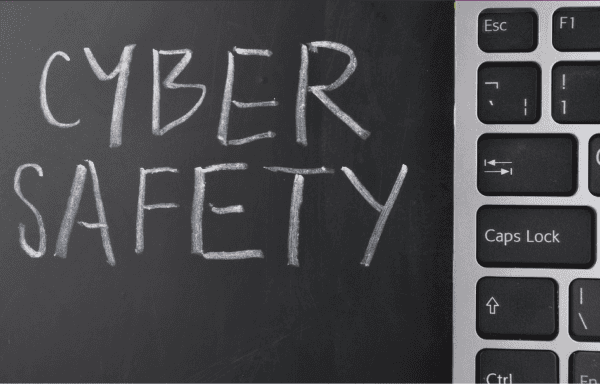How to Implement a Successful Cyber Awareness Program

Have your employees ever learned about cybersecurity awareness in October? If your answer is yes, it’s probably because every October is Cybersecurity Awareness Month. Your cyber awareness program should not be limited to just Cybersecurity Awareness Month, but should be a year-round focus for your company’s cybersecurity strategy, incorporating regular cybersecurity awareness training.
According to a study conducted by Stanford University, human error is responsible for 88% of data breaches. It is crucial for organizations to ensure that their employees are well-informed and well-trained in order to secure their systems. The study titled “Psychology of Human Error” highlights that employees are often hesitant to admit their mistakes if they fear severe judgement from their organization.
Understanding the psychology behind human errors is essential for organizations to proactively prevent mistakes from turning into data leaks. The study also reveals that nearly 50% of employees admitted to being “very” or “pretty” certain that they have made errors at work that could potentially lead to security issues for their company. Having well-informed and well-trained employees is the most important thing you can do to secure your organization.
Developing a cybersecurity awareness training program that works

Developing an engaging and effective cyber awareness program that resonates with your employees can be challenging. Here are key considerations:
- Create a general cyber awareness training program
- Conduct regular phishing campaigns
- Ensure regulations/role-specific training
- Make cybersecurity awareness fun and interactive
- Embrace positivity: uplift, don’t criticize
- Make cyber awareness relatable and topical
Security awareness training works by empowering employees to detect and prevent phishing attacks, leading to measurable behavioral changes in organizational security practices.
General cyber awareness training program
To establish an effective cybersecurity awareness program, it is crucial to begin with the fundamentals. This entails educating your employees on the significance of password security, data protection, and practicing safe browsing habits. Equipping them with the necessary resources and tools to defend sensitive information against cybercriminals is paramount.
A good cyber awareness training program doesn’t happen just one time in the history of the company. This training should be conducted annually for all employees as well as within a month of new hires’ start date. I recommend shorter, more frequent training so that employees can retain the information and are less likely to get distracted. The different formats of these types of training (videos, tutorials, infographics, interactive training modules) all have their own merits and should be decided through employee feedback and your own knowledge of your business. Incorporating diverse awareness training content, such as gamified and personalized training materials, can help address specific areas where employees need the most support. This content should be frequently updated to tackle new and emerging threats, including customizable phishing simulations based on each user’s skill level, geolocation, department, and language.
Phishing attacks campaigns
Implement phishing simulations at least quarterly. Why? According to the US Cybersecurity and Infrastructure Security Agency (CISA), more than 90% of all cyber attacks begin with phishing. Phishing attempts can begin to be mitigated with strong and consistent awareness training, which include simulated phishing attacks.
Phishing simulations and phishing awareness training needs to be more than sending an email. Promote employee education and understanding of phishing attacks and the associated risks by having a “consequence” piece to the “action” of either clicking a malicious link in the phishing email or reporting the suspicious email to the appropriate team. For example:
- Employee selects the malicious link in the simulated phishing campaign:
- The employee is taken to a URL explaining phishing attacks and how to attempt to spot these emails in the future. This employee may need some additional training modules on phishing in order to remediate learning.
- Employee reports the simulated phishing attack:
- Provide the employee with a thank you or small recognition for being alert.
It is very important to track the results of these campaigns in order to measure progress over time for individuals and the company as a whole. The progress data can be a strong indicator of if your simulated phishing tests are increasing employee knowledge and therefore decreasing the chance of a successful phishing attack or if your training methods should be modified for a better approach. Additionally, security awareness training results can show a significant reduction in the risk of phishing attacks and offer a substantial return on investment.
Regulations/role-specific training

Different employees throughout the company need different training campaigns as they may face different cybersecurity threats based on their access. Some categories to consider:
- Employees who work with regulated data:
- Employees who work with regulated data need tailored security training specifically for the relevant regulatory compliance. Educating employees on compliance requirements may also help them understand the why behind different security measures.
- High-risk employees
- High risk employees include those who speak to a lot of people outside the organization, such as human resources (HR), sales, and those who may be well-known “large targets” (C-suite). These individuals should receive extra training on phishing and social engineering attacks.
- Developers
- As developers are building your company’s infrastructure, they need to be trained in secure coding.
Using a security awareness training platform can provide comprehensive and engaging training tailored to these specific needs.
Make cybersecurity awareness fun and interactive
Creating a strong cybersecurity awareness culture within your organization is crucial, and there are plenty of engaging strategies to make it happen. A few strategies to consider are:
- Seek input from your employees
- Create interactive events
- Make it fun!
Seek input from your employees
Start by seeking input from your employees on their preferred learning methods and the security issues that confuse them the most. This not only shows that you value their opinions, but also ensures that the training is tailored to their needs. Employee feedback can be collected in a multitude of ways, but consider using a survey as this allows employees to share their knowledge and opinions anonymously.
Create interactive events
To foster a sense of community while promoting the ongoing effort of your security awareness program, include InfoSec topics in town halls and organize events like lunch-and-learns or happy hours. Consider inviting guest speakers and making the sessions interactive.
Make it fun!
Inject some friendly competition by running contests related to current news or recent training sessions, such as submitting the best sample phishing email. And remember, adding an element of fun through games and giveaways can help make cybersecurity a part of your employees’ daily routines. Let’s strengthen your cybersecurity defenses together!
Embrace positivity: uplift, don’t criticize

In the realm of cybersecurity, fostering a collaborative environment between employees and the security team is crucial for enhancing the organization’s security posture. Remember, nearly 50% of employees are “very” or “pretty” certain that they have made errors at work that could potentially lead to security issues. Through a collaborative environment, your organization’s security posture can be a team effort, safeguarding digital assets and protecting against potential security breaches.
However, it’s important to approach this “team effort” in a manner that encourages open communication and empowers employees to actively participate in maintaining a secure workplace. Two suggestions to encourage this are through building trust and providing incentives.
Building trust
Many employees perceive the security team as working against them, rather than with them. Implementing “walls of shame” or publicly discussing employees who fall victim to phishing will only increase fear and discourage them from seeking help or expressing concerns. It is essential to remember that the human risk aspect comes from humans themselves, so it is important to discuss mistakes and how to improve in a human way.
If your team chooses to address training failures and employee mistakes, which is sometimes necessary in order to grow and continue to build security awareness, work with employees privately, and if necessary, in collaboration with HR.
Providing incentives
In addition to having security conversations in a positive and constructive manner in order to build trust, consider offering incentives for repeated security wins. For example, enter everyone who correctly identifies and reports phishing simulations into a raffle. This approach not only encourages employees to actively engage in security practices but also creates a positive reinforcement system that boosts overall cybersecurity awareness and participation.
Make cyber awareness relatable and topical
Keeping cyber awareness training lessons relevant and relatable is crucial to ensure their effectiveness. You can do this by providing real world examples and fostering discussions about personal data security.
- Provide real world examples:
- To enhance the effectiveness of training lessons, it’s beneficial to provide real-world examples. These examples resonate even more when they are relevant to your specific industry. Examples could include:
- Phishing emails that mimic well-known companies
- Sharing a story of a major data breach
- Mentioning recent ransomware attacks
- Discussing deceptive downloads that carry malware
- Sharing how personal information can be compromised when using public Wi-Fi
- To enhance the effectiveness of training lessons, it’s beneficial to provide real-world examples. These examples resonate even more when they are relevant to your specific industry. Examples could include:
- Fostering discussions:
- Engage in conversations with employees regarding steps they can take to safeguard their personal data. By cultivating good cybersecurity habits at home, it becomes easier to maintain those habits in the office. Examples could include
- Enabling two-factor authentication to safeguard their personal data on their online accounts.
- Regularly monitoring their credit reports for suspicious activity.
- Using a virtual private network (VPN) when connecting to public Wi-Fi networks.
- Engage in conversations with employees regarding steps they can take to safeguard their personal data. By cultivating good cybersecurity habits at home, it becomes easier to maintain those habits in the office. Examples could include
Consistency is the cornerstone of cyber awareness. Simply discussing cybersecurity best practices once a year in a cyber awareness program is not enough. The ever-evolving cybersecurity landscape demands that we stay updated on the latest developments in online security. It is crucial to ensure that your cybersecurity awareness program evolves and adapts to emerging threats. The most secure organizations I have come across treat security as an integral part of their business, rather than a hindrance.
The TL;DR takeaways

To enhance the cyber awareness of your employees and your organization as a whole, consider the following:
- Regularly remind employees of cybersecurity best practices.
- Provide practical examples of how to apply these best practices in everyday situations.
- Encourage employees to reach out to the Information Security (InfoSec) team for any concerns.
By fostering a culture of cybersecurity best practices and maintaining consistency, cybersecurity will become a daily habit throughout the year.
Conclusion
An effective cyber awareness program is critical in your cybersecurity strategy, creating a safe and secure online environment for your business. By starting with the basics, conducting regular training sessions, making it engaging, providing positive reinforcement, and keeping up with the latest developments, businesses can mitigate cybersecurity risks and protect themselves from online security threats like phishing. Remember, cybersecurity is a shared responsibility that requires a proactive approach and commitment from all employees.
Additionally, leveraging cybersecurity-as-a-service (CSaaS) can further strengthen your business’s cybersecurity strategy. By partnering with experts in the field, you can ensure a robust and comprehensive approach to safeguarding your digital assets. Cybersecurity-as-a-service provides specialized knowledge, cutting-edge technologies, and continuous monitoring to detect and respond to emerging threats, allowing you to focus on your core business operations with peace of mind.
By prioritizing a security awareness training program, your company can enhance its cybersecurity strategy and protect sensitive information from potential cyber threats. Utilizing a security awareness training platform can streamline the process and ensure comprehensive coverage of essential topics.
If you are in search of a trusted partner to assist with your security awareness program or to bolster your cybersecurity strategy, look no further than the Cyber Defense Group. Our dedicated team of cyber experts are at your service, equipped with the knowledge and tools to help secure and protect your digital landscape. Don’t hesitate to reach out to us. Together, let’s build a safer digital future for your business today.
